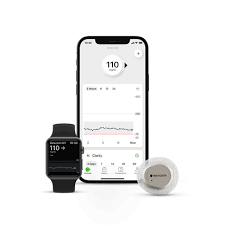 Can you Lower Blood Sugar By Increasing Fiber Intake?
Can you Lower Blood Sugar By Increasing Fiber Intake?
By: Jessica Hrdlicka MS, RD, LD/N, CDCES
Having adequate fiber in your diet is not only great for your heart by lowering cholesterol, but it can aid in weight loss, prevention of colon cancer and lower blood sugars!
Fiber slows down digestion which creates a slower blood sugar rise after eating, increased satiety and better digestion. Having adequate fiber also promotes good gut bacteria and healthy microbiome. Recommendations for most adults are 25-38g fiber intake per day.
Here is how to add more fiber to your meals throughout the day:
- Eat more salads! Adding salad before meals or as an addition t your favorite meals is an easy way to add fiber through greens, cucumber, tomatoes, carrots, radishes, chickpeas, artichokes, onions, peppers, etc. You can get creative with different salad ingredients and combinations, so the options are endless.
- Add berries to your meals. Having berries with cottage cheese, Greek yogurt, salads or as a dessert is a fun and sweet way to add tons of fiber to your meals.
- Add nuts or seeds! Topping salads, yogurt, cottage cheese, oatmeal with nuts or seeds can add a delicious crunch filled with fiber. Also nuts & seeds make a great mid day snack or great snack option when traveling.
- Think of whole grains and complex carbs. Despite what most people think having carbohydrates with your meals is important as someone living with diabetes. Adding grains such as wild rice, quinoa or barely to meals can add delicious flavor. As well as complex carbohydrates such as sweet potatoes, beans, squash or lentils. You can add them to soups, salads or make a yummy side dish.
For more information on diabetes management, chronic kidney disease weight loss and nutrition, call 561-659-6336 ext 8012 to schedule an appointment with a certified diabetes care education specialist, registered dietitian or class today. Please enjoy our May 2024 Living Well with Diabetes Newsletter! Osteoporosis in Young Adults By: Geetanjali Kale, M.D. Osteoporosis is usually disease of older adults and post-menopausal women. It is challenging to diagnose and treat diagnosis of osteoporosis and/or diagnosis of low bone density in adults less than 50 years of age. First step is to define if it’s true clinical osteoporosis or just low bone mass on imaging. We have accelerated bone development and and accrue all our bone mass by age 30 years. If for some reason, individuals are not able to accrue adequate bone mass by age 30 years, those individuals will always have relatively low bone density. This can happen due to many conditions, can be because menses were delayed, hypogonadism of many forms, eating disorders such as anorexia nervosa, malnutrition, autoimmune disorders and Crohn’s disease, inflammatory conditions, HIV, gastric bypass etc. metabolic disorders of bone, calcium metabolism etc. Low bone density can also be a result of chronic smoking, significant alcohol use and drug use. Glucocorticoids or steroid use has a significant impact in lowering bone density. This low bone density can translate into clinical osteoporosis if patients sustain low trauma fractures. Based on blood work, clinical presentation, presence of ongoing risk factors, presence of fractures, etc. you doctor will decide if you need any treatment to make your bones stronger. Not every patient with low bone density on DEXA scan in absence of low trauma fracture needs medications such as bisphosphonates or bone building medications. If you are under age 50 and have sustained a low trauma fracture and is concerned about health of your bones, please reach out to one of our physicians at Palm Beach Diabetes and Endocrine Specialists, and we will be happy to take care of you! Do I still Need to do Finger sticks if ‘m Using a Sensor? By: Monika Lambertson MS, RD, LD/N, CDCES The answer is a resounding YES! Finger sticks are still a necessary tool when using a sensor and therefore it is important to always keep a blood sugar meter and test strips on hand. A fingerstick measures the glucose level in the blood at the precise moment when you take it. The sensor on the other hand measures the glucose level in the fluid between cells under the skin (the interstitial fluid), which shows where your glucose levels were approximately 5-15 minutes ago. This is known as sensor lag time. That’s why fingersticks and sensor glucose readings rarely match exactly. When blood sugar levels are more stable - like upon waking or before a meal - the blood sugar and sensor readings will be closer together. When blood sugar levels are changing rapidly - like after meals or exercise - the numbers will be farther apart. Accuracy studies show that sensor glucose readings are typically within ~ 10% of the true value. For example, if your blood glucose is actually 150mg/dl, the sensor might display a reading around 135mg/dl or 165mg/dl. When should I use my blood sugar meter? It is recommended to use a fingerstick value in the following situations:
When should I call technical support?
Dexcom Tech Support 888-738-3646 (24 hours) Freestyle Libre Tech Support 855-632-8658 (7 days a week 8am-8pm EST) When should I call the office?
For more information and additional manufacturer-specific tips, click on the following links: Abbott Freestyle Libre https://www.freestylelibre.us/content/dam/adc/freestylelibreus/documents/FreeStyle%20Libre%2010%20day%20-%20Sensor%20Adhesion%20Guide.pdf Dexcom Sensor adhesion https://s3-us-west-2.amazonaws.com/dexcompdf/HCP_Website/LBL017084_Adhesive_supplements.pdf Sensor removal https://s3-us-west-2.amazonaws.com/dexcompdf/HCP_Website/LBL017086_Removal_techniques_and_agents.pdf sensitive skin https://s3-us-west-2.amazonaws.com/dexcompdf/HCP_Website/LBL017085_irritated_or_sensitive_skin.pdf Remember most insurance plans cover meeting with a certified diabetes care education specialist up to 2 times per year, so if you are desiring to lower your A1c, learn how to use your sensor and feel better this year call 561-659-6336 ext 8012 to schedule your appointment today! Healthy Meal Planning & Weight Loss Class Sessions! Join our classes to stay motivated & healthy in 2024!
West Palm Beach Location (Virtual or In Person!) Temple Israel 1901 N. Flagler Drive West Palm Beach, FL 33401 Tuesday July 9th 10am-12pm Boynton Beach Location: 6056 Boynton Beach, Suite 245 Boynton Beach FL 33437 Tuesday June 18th10am-12pm If interested attending this program please contact our scheduling department at (561) 659-6336 Extension 8001 today! At Healthy Living with Diabetes we want to ensure that you are satisfied with all services received. We also would like your input on educational workshops that you would like us to offer, information you would like to read about in Healthy Living with Diabetes Monthly or feedback on any workshop that you may have attended. You can contact the director of education personally by email jcook@PBDES.COM or leave a message at (561) 659-6336 ext. 8012. We would love to hear from you! Check us out on the web!
www.facebook.com/pbdeseducation |




 www.palmbeachdiabetes.com
www.palmbeachdiabetes.com